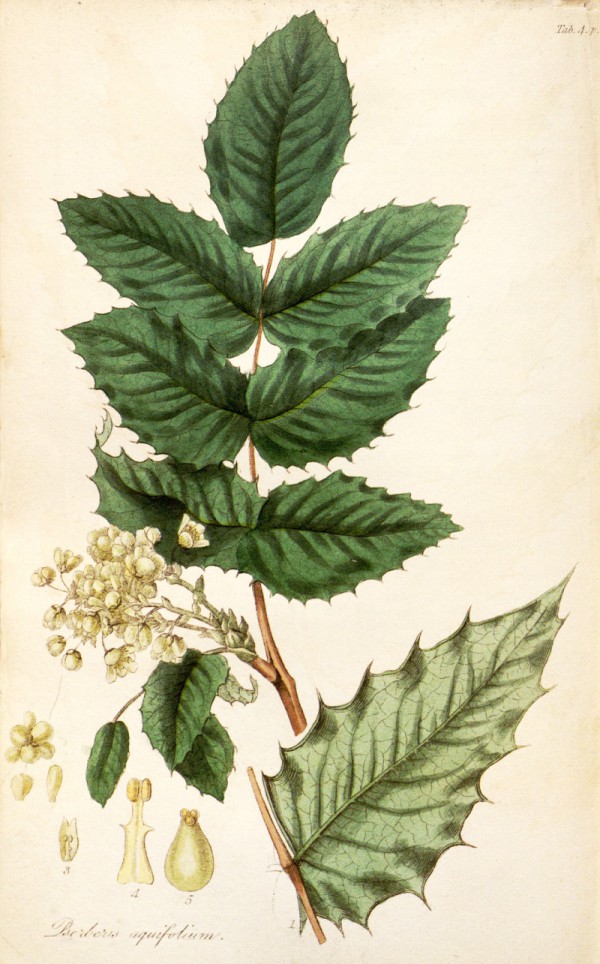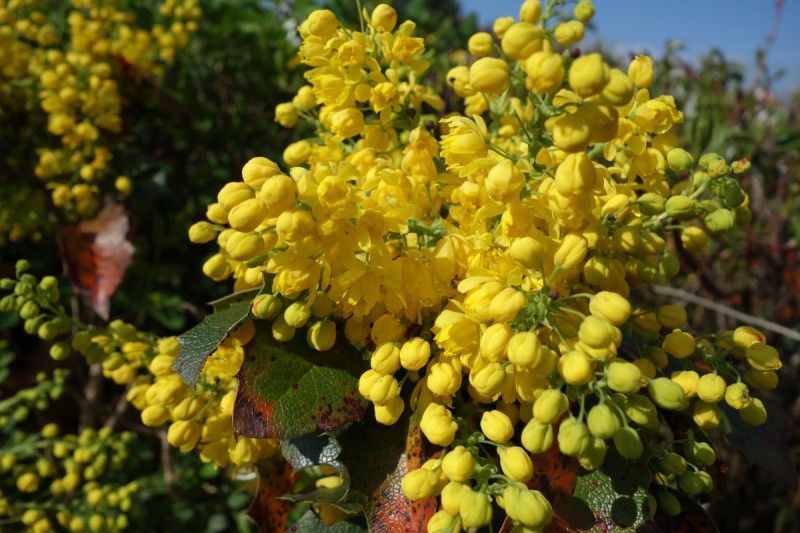Berberis aquifolium Pursh - syn.Mahonia aquifolium (Pursh) Nutt. - Berberidaceae
Oregon grape, (Gewöhnliche) Mahonie
Ornamental evergreen shrub, up to 1.50m high; native to western North America, naturalized in Europe, cultivated elsewhere as ornamental; leaves leathery, pinnate (5-13 thorny leaflets), turning red in winter; inflorescences racemose, dense, 30-60-flowered; flowers yellow; berries oblong-ovoid, 1cm in diam., blue-black, glaucous.
„Medicinally, various root preparations of Berberis aquifolium were used by Native Americans for stomach trouble, hemorrhages, and tuberculosis; as a panacea, a tonic, a gargle, and an eye wash; and to purify blood. Leaves and roots were used in steam baths to treat yellow fever; karok was used as a poison; and the tips of stems were used to treat stomach aches (D. E. Moermann 1986).“
http://www.efloras.org/florataxon.aspx?flora_id=1&taxon_id=233500223
The odor of the yellow flowers „…is described as sharp amylic, honey-like with chamomile notes. The odor concentrate contained phenylacetaldehyde, 2-phenylethanol, (E)-ocimene and cinnamic alcohol as main constituents. Additionally, we identified 3,4,5-trimethoxytoluene, a relatively uncommon flower constituent, in remarkable concentration of about 12%.“
[Surburg et al., Volatile compounds from Flowers, in: Teranishi, R.;Buttery, R. G.;Sugisawa, H. Bioactive volatile compounds from plants. (Book) 1993, 180]
Analyses of air samples around blooms of Oregon grape shrubs revealed the consistent presence of phenylacetaldehyde (124ng/h/flower), α-pinene (87ng/h), (E)-β-ocimene (54ng/h), limonene (43ng/h), β-pinene, sabinene, myrcene, and benzaldehyde.
[Characterization of the floral odor of Oregongrape: possible feeding attractants for moths, Landolt, P.J., Smithhisler, C.L., Northwest science, Vol.77(1), 2003, 81-86]
https://research.wsulibs.wsu.edu:8443/xmlui/bitstream/handle/2376/919/v77%20p81%20Landolt%20and%20Smithhisler.PDF
„The small purplish-black fruits, which are quite tart and contain large seeds, are included in smaller quantities in the traditional diets of Pacific Northwest aboriginal peoples, mixed with Salal (Gaultheria shallon) or another sweeter fruit. Today they are sometimes used to make jelly, alone or mixed with salal.“
https://en.wikipedia.org/wiki/Mahonia_aquifolium
„The pea-greated, oval to chubby, steelblue riped fruits and the produced intensive red juice from it and used early as dye. The fruits and the dark red dye are practical alkaloidfree. Both products are not permitted as food dye in Germany and other countries. Mahonia roots may contain 2.4-4.5% of alkaloids and are used to treat various skin diseases.“
[Die Mahonie (Mahonia aquifolium/Pursh/Nutt.), eine brauchbare Obstpflanze, Seidemann, J., Deutsche Lebensmittel-Rundschau, 94(7), 1998, 217-220]
„The energy, reducing sugar, protein, cellulose, oil, ash, acidity, total phenolics, total anthocyanin and soluble solid matter values of Mahonia aquifolium fruits were determined to be 47.85 kcal/100g, 47.6 g/kg, 30.8 g/kg, 17.8 g/kg, 21.7 g/kg, 11.0 g/kg, 33.7 g/kg, 4574.6 mg/kg, 655.64 mg/kg and 176.0 g/kg, respectively.“
[Some physico-chemical properties of Mahonia acquifolium fruits., Marakoglu, T., Akbulut, M., Calisir, S., Asian J. Chem, Vol.22(2), 2010, 1606-1614]
The antioxidant capacity of methanolic crude extracts of B.aquifolium fruits was tested (DPPH• radical scavenging assay) and the study has shown that the fruits are attractive for consumption. The highest protection of phosphatidylcholine liposome membranes was observed in the case of B.aquifolium methanolic extract, which exhibited the highest content of anthocyanins (18.4%). These were mainly cyanidin 3-O-rutinoside (43%) and delphinidin 3-O-rutinoside (30%).
[A Comprehensive Study on Antioxidant Properties of Crude Extracts from Fruits of Berberis vulgaris L., Cornus mas L. and Mahonia aquifolium Nutt., Pyrkosz-Biardzka, K., Kucharska, A.Z., Sokół-Łętowska, A., Strugała, P., Gabrielska, J., Polish Journal of Food and Nutrition Sciences, Vol.64(2), 2014, 91-99]

Pursh, F., Flora Americae septentrionalis, vol.1, t.4 (1814)
http://plantgenera.org/species.php?id_species=137685

oregon grape flowers, CC BY-SA 3.0, Author: Andreas Kraska
